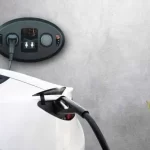NYPD Debuts New ‘Windshield Boot’ for Parking Scofflaws: Good Luck Getting This Off
The post NYPD Debuts New ‘Windshield Boot’ for Parking Scofflaws: Good Luck Getting This Off appeared first on Healthy Holistic Living.
Parking in New York City is notoriously challenging, and for many, it’s an endless game of cat and mouse with parking enforcement officers. But now, the NYPD has unveiled a new tool in its arsenal: the “windshield boot,” also known as the “Barnacle Device.” This innovative device aims to immobilize vehicles that violate parking regulations, promising to make it much harder for offenders to evade the consequences of their actions. In this article, we’ll explore the details of this new enforcement method, its implications for parking violators, and the potential impact it could have on New York City streets.
The Introduction of the NYPD’s Windshield Boot
Parking enforcement in urban areas has long been a multifaceted challenge, with authorities constantly seeking innovative solutions to combat the persistent issue of parking violations. In this ongoing battle, the late hours of Thursday evening marked a watershed moment for the New York City Police Department (NYPD) as it unveiled its latest enforcement technology: the windshield boot. This groundbreaking device, resembling a large, colorful sticker, shifts the paradigm in how the city addresses parking violations.
Traditionally, authorities have used enforcement measures such as wheel boots to immobilize vehicles found in violation of parking regulations. However, these traditional methods have not been without their shortcomings, with offenders sometimes managing to evade consequences through various means. The introduction of the windshield boot heralds a new era of enforcement effectiveness, presenting offenders with a formidable obstacle that they cannot easily overcome.
Revolutionizing Parking Enforcement
Unlike its predecessors, the windshield boot is specifically designed to adhere firmly to the windshield of offending vehicles. This unique placement not only ensures greater visibility but also poses a significant challenge to would-be violators. Once affixed to the windshield, the boot effectively immobilizes the vehicle, making it nearly impossible to drive away without first addressing the violation. This represents a significant departure from traditional wheel boots, which, despite their effectiveness, offenders have occasionally circumvented using specialized tools or sheer determination.
The debut of the windshield boot underscores the NYPD’s commitment to enhancing parking enforcement efforts and promoting compliance with parking regulations. By introducing a novel and highly visible enforcement tool, the department aims to send a clear message to would-be violators that illegal parking will not be tolerated. Moreover, the windshield boot serves as a proactive deterrent against improper parking practices, helping to alleviate parking congestion and improve traffic flow in the city’s bustling streets.
As the NYPD continues to deploy the windshield boot across the city, it is poised to have a transformative impact on parking enforcement efforts. By leveraging innovative technology and strategic placement, the department aims to create a safer, more orderly urban environment for residents, businesses, and visitors alike. The introduction of the windshield boot represents not only a significant milestone in the ongoing battle against parking violations but also a testament to the NYPD’s unwavering commitment to public safety and quality of life in New York City.
Addressing Parking Congestion and Safety Hazards
The introduction of the windshield boot by the NYPD’s chief of transportation serves multiple crucial purposes in the ongoing efforts to manage parking issues in New York City. Here are some key points highlighting the significance of this enforcement measure:
Holding parking violators accountable: The primary objective of the windshield boot is to ensure that parking violators are held accountable for their actions. By immobilizing vehicles that are illegally parked or in violation of other regulations, law enforcement can effectively deter future violations and encourage compliance with parking laws.
Reducing parking congestion: Illegal parking contributes significantly to parking congestion in urban areas, exacerbating traffic flow issues and creating headaches for both drivers and pedestrians. The windshield boot serves as a deterrent against improper parking practices, helping to alleviate congestion and improve the overall efficiency of the city’s transportation infrastructure.
Addressing safety hazards: Improperly parked vehicles pose various safety hazards, from obstructing fire hydrants to impeding the flow of emergency vehicles. By immobilizing these vehicles, the NYPD can mitigate safety risks and ensure that emergency responders have unimpeded access to critical locations during emergencies.
It becomes evident that this enforcement measure represents a significant step forward in the ongoing efforts to manage parking issues in New York City. Through a combination of deterrence, accountability, and promotion of compliance, the windshield boot promises to make a tangible impact on the city’s streets, creating a safer and more efficient environment for all.
How the Windshield Boot Works
The windshield boot operates on a simple yet effective principle. When enforcement officers identify a vehicle as being in violation of parking regulations, they affix the device to the front windshield. Once in place, the boot cannot be easily removed by the driver or any passengers inside the vehicle. Attempting to drive with the boot attached could result in damage to the windshield or the vehicle itself, further discouraging offenders from attempting to flee the scene.
Comparison with Traditional Wheel Boots
For decades, traditional wheel boots have been a staple of parking enforcement efforts, serving as a deterrent against illegal parking and vehicle immobilization. However, despite their widespread use, traditional wheel boots have several inherent drawbacks that limit their effectiveness in certain situations. Here’s a closer look at how the windshield boot compares to its predecessor:
Removal challenges: One of the primary limitations of traditional wheel boots is their susceptibility to removal by determined offenders. Through various methods, such as cutting or sawing through the locking mechanism, some individuals have been able to free their vehicles from wheel boots, rendering the enforcement measures ineffective. In contrast, the windshield boot presents a more formidable challenge for offenders, as it adheres directly to the vehicle’s windshield, making removal significantly more difficult and impractical.
Installation process: Another consideration when comparing traditional wheel boots to the windshield boot is the installation process. Wheel boots typically require enforcement officers to physically attach the device to one or more of the vehicle’s wheels, a process that can be time-consuming and labor-intensive. In contrast, the windshield boot offers a more streamlined approach, eliminating the need for physical contact with the vehicle’s tires. This not only reduces the time and effort required for installation but also minimizes the risk of injury or accidents during the enforcement process.
Adaptability to different vehicle types: Traditional wheel boots are designed to fit a wide range of vehicle sizes and types, from compact cars to larger trucks and SUVs. However, their universal design may not always provide a secure fit, particularly on vehicles with unique tire configurations or aftermarket modifications. The windshield boot, on the other hand, is adaptable to virtually any vehicle with a windshield, ensuring consistent enforcement across different vehicle types and reducing the likelihood of evasion by offenders.
Potential Challenges and Limitations
While the windshield boot represents a significant advancement in parking enforcement technology, it is not without its potential challenges and limitations. As with any new technology, there are various factors to consider regarding its practical implementation and effectiveness. Here are some potential challenges and limitations associated with the windshield boot:
Tampering and removal attempts: Despite its secure attachment to the vehicle’s windshield, there is the possibility of offenders attempting to tamper with or remove the windshield boot using improvised methods. Whether through brute force or creative techniques, determined individuals may seek to circumvent the enforcement measure, posing a challenge for law enforcement agencies tasked with maintaining compliance.
Weather conditions: Extreme weather conditions such as heavy rain, snow, or extreme temperatures could potentially affect the adhesive properties of the windshield boot, leading to reduced effectiveness or premature detachment. While designers built the device to withstand typical urban weather conditions, unforeseen circumstances may affect its performance, requiring enforcement personnel to continuously monitor and maintain it.
Development and testing: The effectiveness of the windshield boot relies heavily on rigorous development and testing processes to ensure its reliability and durability in real-world conditions. While the NYPD has likely conducted extensive testing prior to the device’s deployment, unforeseen issues or challenges may arise during actual enforcement operations, requiring ongoing refinement and adaptation of the technology.
Despite these potential challenges and limitations, the NYPD is committed to using the windshield boot as a valuable tool in its ongoing efforts to address parking violations and improve traffic safety in New York City. By proactively addressing potential issues and implementing safeguards to mitigate risks, law enforcement agencies can maximize the effectiveness of this innovative enforcement measure, ensuring its continued success in promoting compliance and accountability among parking violators.
Public Reception and Legal Implications
The introduction of the NYPD’s windshield boot has elicited mixed reactions from New Yorkers. Many support the initiative, seeing it as an effective measure to deter parking violations and enhance street safety. However, critics have significant concerns about the potential for abuse or misuse, particularly in cases where enforcement errors or outdated information might wrongfully target vehicles, leading to unjust penalties.
Legally, the use of the windshield boot raises important questions about vehicle owners’ rights, including how to contest wrongful booting and seek recourse for any damages incurred. The process typically involves an administrative review where owners can challenge the violation, highlighting the need for transparent and efficient procedures to minimize inconvenience and financial burdens on affected individuals.
Future Applications and Adaptations
As the NYPD expands its use of the windshield boot throughout New York City, the door opens for numerous enhancements and adaptations to this cutting-edge technology. The potential upgrades include incorporating smart technology, such as GPS tracking, which would allow for the precise location of offending vehicles. This feature, along with remote monitoring capabilities, would streamline the enforcement process, eliminating the need for physical intervention by officers.
Additionally, the windshield boot could serve as an effective tool for collecting data on parking patterns and compliance rates. This data would provide law enforcement with valuable insights into parking behaviors, aiding in the development of more focused and efficient enforcement strategies.
Collaboration with private companies and research institutions could further accelerate innovation in parking enforcement technology. Such partnerships might lead to pilot testing of new technologies, enabling rapid adjustments based on real-world feedback. Future adaptations might also include integrating the windshield boot with existing transportation and law enforcement systems, which would streamline administrative processes and enhance operational efficiency, ensuring consistent adherence to parking regulations.
As advancements continue, it’s crucial to ensure that parking enforcement technologies are implemented equitably. Future developments should aim for inclusivity, perhaps through educational outreach about parking regulations and making accommodations for individuals with disabilities or limited mobility.
In summary, the future of parking enforcement technology holds immense promise for enhancing efficiency, improving compliance, and fostering innovation in urban mobility. By embracing advancements such as smart boot technology, data-driven insights, and strategic partnerships, law enforcement agencies can stay at the forefront of innovation and effectively address the evolving challenges of parking management in modern cities. The continued evolution of the windshield boot represents just one example of the transformative potential of technology in shaping the future of urban transportation and mobility.
The Future of Parking Enforcement in New York City
The NYPD’s introduction of the windshield boot represents a significant advancement in parking enforcement in New York City. This new device, aimed at increasing compliance with parking regulations, promises to address the city’s chronic issues of parking space scarcity and vehicle density effectively. By overcoming the limitations of traditional wheel boots with a solution that is harder to tamper with and more visible, the initiative highlights the city’s commitment to maintaining public order and safety.
Successful implementation will depend on transparent enforcement and clear guidelines for contesting penalties, ensuring the initiative is perceived as fair. The city must also be proactive in assessing the boot’s real-world impact and ready to adapt based on feedback. If effectively executed, the windshield boot could become a model for other cities, demonstrating how technology can resolve complex urban challenges while improving safety and mobility.
Looking ahead, the experience of New York City with the windshield boot could serve as an instructive model for other cities facing similar challenges. As urban centers around the world continue to grow and evolve, the adoption of innovative technologies like the windshield boot could play a crucial role in shaping the future of urban mobility and law enforcement. By setting a precedent for integrating technology into public administration, New York City is not just solving its own parking problems but potentially leading a global shift towards smarter, more equitable urban management.
The post NYPD Debuts New ‘Windshield Boot’ for Parking Scofflaws: Good Luck Getting This Off appeared first on Healthy Holistic Living.












